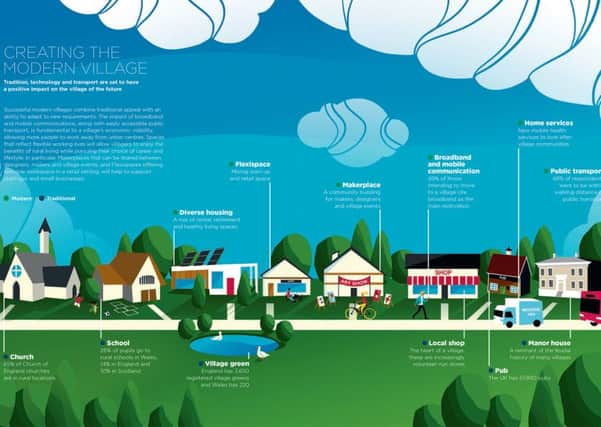Renaissance for villages as rural life beats towns and city living


Geographers have long predicted a flight to the cities but a new report from Strutt and Parker shows that dreams of escaping to a country idyll are a driving force in the housing market.
Researchers at the estate agency have been studying transaction data and surveys for three years and have seen the emergence of a new trend – a yearning to move to amenity-rich villages.
Advertisement
Hide AdAdvertisement
Hide AdStephanie McMahon, Head of Research at Strutt and Parker, says: “The UK might seem to be focused on urbanisation but we believe a new, overlooked trend is set to shape Britain’s housing market over the coming decades and that is the desire to move back to rural.
“Existing research would suggest cities have the upper hand over villages. It states that by the mid-century there will be approximately 65 million people living in Britain’s cities, compared to just eight million in rural areas. However, as the urban trend has gathered pace in the UK, a number of negative traits have begun to appear such as a rise in inadequate housing provision, urban sprawl and increased pollution.”
The Housing Futures report reveals that just over a fifth of those who are moving home now want to live in a village, making it the most popular type of location. Only 14 per cent want a market town and only 12 per cent a city or a suburb.
Factors shaping the village revival include the ability to work from home. Access to broadband was a key factor for 49 per cent of those intending to escape to the country, while 38 per cent highlighted mobile connectivity.
Advertisement
Hide AdAdvertisement
Hide AdThere is also a significant increase in those prepared to rent rather than buy. A tenth of those wanting to move to a village would live in a professionally managed, private rental property, up from just one per cent in the 2013 Housing Futures survey.
Ease of access is an important issue for those who crave village life, with 60 per cent wanting a shop within walking distance, 48 per cent want access to local transport and 45 per cent to medical facilities.
According to DEFRA, in 2013/14, the UK saw net internal migration of 60,000 people to predominantly rural areas in England. It is a trend that has been positive every year since 2001. The influence that technology is having on shopping, communications and working habits is helping to transform villages and the type of people who want to live in them, according to James Farrell, Head of Consultancy at Strutt and Parker.
He says: “Technology is helping to change the rural economy, which now plays a key role in creating jobs and prosperity. England’s rural economy accounts for £210 billion of economic output and hosts over 25 per cent of all registered businesses. New companies are thriving in rural locations, including hi-tech manufacturing, food processing, the service sector, retail and power supply in the form of renewables.”
Advertisement
Hide AdAdvertisement
Hide AdStephanie McMahon adds: “The expansion of broadband and mobile communications has seen a greater uptake of working from home in rural locations compared to urban areas. It seems that the same factors that once drove urbanisation – improving economic and social conditions – are now inspiring the village revival.”
Strutt and Parker’s report says that rural housing will need to adapt to suit the new buyers and this includes the provision of built to rent properties and “platinum places” with gyms and swimming pools for retirees.
Yorkshire’s picture postcard villages are a major attraction for buyers within the region and from further afield. James Wort, of Strutt and Parker’s Harrogate office, says: “About 30 to 40 per cent of those buying in the most sought-after villages around Harrogate are from London. Many of them will commute back to work down south and will work at home part of the time.”
*Strutt and Parker’s Housing Futures Report identified four distinct tribes of would-be village dwellers. These include the Downtons, the mega rich who want to buy or rent a prestigious £2m plus country house; the Elderflowers, who are the over 65s and the UK’s largest demographic; the Rusticarians, who are homeworkers employed in higher skilled roles and rural entrepreneurs; the Rubies, rural newbies who want to move to a village to raise their children and the Onesies, single-person households. It is estimated that by 2033 sole occupiers will make up 41 per cent of all households, a trend driven by rising life
expectancy and divorce.